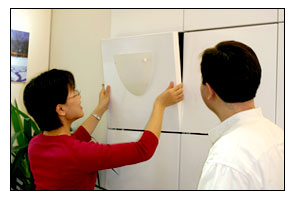TROY, N.Y., Dec. 16 -- A novel concept for lighting homes and offices integrates LED technology with building materials and systems to create electronic walls and ceilings. The design includes interchangeable, modular panels with LED lighting fixtures that "snap" in and out of an electrical grid. Occupants can change the location of light fixtures or introduce new ones to suit their needs.
Interchangeable, modular panels with integrated LED lighting fixtures snap in and out of a modular electrical grid. The panels can be rearranged easily and will work in any section of the wall or ceiling. (Photo: RPI's Lighting Research Center/Dennis Guyon)
Recently unveiled by the Alliance for Solid-State Illumination Systems and Technologies (ASSIST), an LED industry group organized by the Lighting Research Center (LRC) at Rensselaer Polytechnic Institute (RPI), the new concept "represents a paradigm shift in the way people think about lighting and the way we build and design interiors," said Nadarajah Narendran, PhD, LRC director of research and head of its Solid-State Lighting Program.
The design team, led by Narendran and Russ Leslie, LRC associate director and architect, built a full-scale model of an executive office at the LRC to showcase the group adaptable lighting concept.
Rearranging the LED panels on the walls and ceiling in the room is easier than moving furniture, according to the researchers. There is no need to drill holes, patch drywall, hire an electrician or lay out the room according to where the locations of electric sockets. Once in place, the LED panels are controlled by a touch-screen LCD panel mounted on the wall.
According to Narendran, over the past 100 years traditional lighting has been seen as an add-on to spaces. LEDs, however, offer new ways to light an area. This rapidly evolving technology can be embedded into any type of architecture due to its compactness, durability and longevity, he said.
ASSIST is a collaboration among researchers, manufacturers, utilities and government organizations. Its goal is to identify and reduce major technical hurdles and to help LED technology gain widespread use in lighting applications. On behalf of ASSIST, the LRC conducts research, demonstration and evaluation, and educational activities. ASSIST sponsors include Boeing, GELcore, the New York State Energy Research and Development Authority, Nichia America Corp., Osram Sylvania, Philips Lighting and the US Environmental Protection Agency.
For more information, visit: www.lrc.rpi.edu